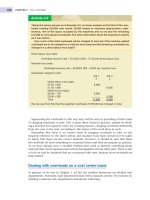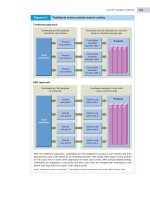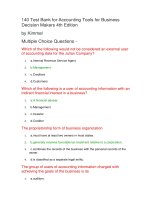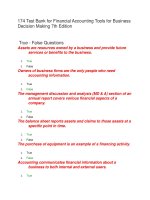Managerial economics economic tools for todays decision makers 7th edtion by keat young and erfle chapter 14
Bạn đang xem bản rút gọn của tài liệu. Xem và tải ngay bản đầy đủ của tài liệu tại đây (135.9 KB, 25 trang )
Chapter 14
Government and
Industry
Outline
•
•
•
•
Rationale for government involvement
Stabilization of the economy
Doing business with the US government
Government deregulation, and
mergers/acquisitions
• Government protection of intellectual
property
Copyright ©2014 Pearson Education, Inc. All rights reserved.
14-2
Learning Objectives
• Cite the major functions of government in a market
economy
• Understand the meaning of market externalities and
the reasoning of the Coase theorem
• Understand the causes and consequences of the
2007–2009 financial crisis
• Explain why firms merge and why, in particular,
firms have chosen to merge in markets that have
experienced government deregulation
• Briefly explain the concept of intellectual property
(IP) and the role of government in protecting IP
rights
Copyright ©2014 Pearson Education, Inc. All rights reserved.
14-3
Government Involvement
in a Market Economy
• Functions of government in a market
economy
– provide legal and social framework for the
market
– maintain competition in markets by ensuring no
one seller dominates
– redistribution of income and wealth
– reallocation of resources
– stabilization of the aggregate economy
– regulation of natural monopolies
Copyright ©2014 Pearson Education, Inc. All rights reserved.
14-4
Government Involvement
in a Market Economy
• Antitrust laws: legal framework for
competition
–
–
–
–
–
–
Sherman Anti-Trust Act (1890)
Clayton Act (1914)
Federal Trade Commission Act (1914)
Robinson-Patman Act (1936)
Celler-Kefauver Act (1950)
Hart-Scott-Rodino Act (1976)
Copyright ©2014 Pearson Education, Inc. All rights reserved.
14-5
Government Involvement
in a Market Economy
• The purpose of antitrust laws
– economic efficiency
– limit power of large firms and protect smaller
firms
Case study: Microsoft v. U.S. Justice Department
and European Commission
Copyright ©2014 Pearson Education, Inc. All rights reserved.
14-6
Government Involvement
in a Market Economy
• Externalities: under perfect competition
resources are efficiently allocated and social
welfare is maximized, but market
externalities can cause efficiency failure and
welfare loss
– benefit externality: certain benefits accrue to
third parties free of charge; producers cannot
recover all the revenue due, so too little may be
produced
Copyright ©2014 Pearson Education, Inc. All rights reserved.
14-7
Government Involvement
in a Market Economy
• Externalities
– cost externality: producer does not pay all the
costs generated by the product (e.g. pollution);
the product’s price will be lower than if it had
included all cost, thus too much will be produced
Copyright ©2014 Pearson Education, Inc. All rights reserved.
14-8
Government Involvement
in a Market Economy
Copyright ©2014 Pearson Education, Inc. All rights reserved.
14-9
Government Involvement
in a Market Economy
The socially optimal price occurs where the
price of the product equals the marginal social
cost.
At this point, less pollution will be produced than
under competitive conditions.
Social cost = sum of the MC of the product and
the MC of externalities (such as pollution)
Copyright ©2014 Pearson Education, Inc. All rights reserved.
14-10
Government Involvement
in a Market Economy
• Socially optimal price: How can the
optimal equilibrium be attained?
– government can restrict production (e.g. can set
maximum pollution levels for the industry then
sell tradable pollution licenses)
– government can impose a pollution tax
Copyright ©2014 Pearson Education, Inc. All rights reserved.
14-11
Government Involvement
in a Market Economy
• Coase Theorem: government intervention
to eliminate the effect of externalities is not
always necessary
If property rights (e.g. pollution permits) are
assigned, then bargaining between the parties
involved would result in an optimal solution
Copyright ©2014 Pearson Education, Inc. All rights reserved.
14-12
Government Involvement
in a Market Economy
Coase Theorem: Limitations
–
–
–
–
Normative issues (income distribution)
Transaction costs (the costs of bargaining
The potential for unfair bargaining
Incomplete information in the bargaining process
Copyright ©2014 Pearson Education, Inc. All rights reserved.
14-13
Stabilization of the
Aggregate Economy
• Monetary Policy: control of the quantity of
money in the economy and/or interest rates
carried out by the Federal Reserve
– directed at attaining economic growth and price
stability
• Fiscal Policy: changes in the level of
taxation and government spending
authorized by Congress
– designed to achieve macroeconomic goals
relating to output (gross domestic product) and
employment
Copyright ©2014 Pearson Education, Inc. All rights reserved.
14-14
Stabilization of the
Aggregate Economy
• Lags in the effect of both monetary and
fiscal policy
– Time needed to for recognition and analysis of a
problem
– Time needed for implementation of the policy
– Time for the policy to work itself into the
economy and become effective
Copyright ©2014 Pearson Education, Inc. All rights reserved.
14-15
Stabilization of the
Aggregate Economy
• Subprime Loan Financial Crisis: declines in
housing prices accompanied by massive
foreclosures
– Securitization of mortgaged-backed securities
added financial risk.
– Disappearing liquidity in the financial system
– Changing bank regulations to avoid future crisis
– Global financial deregulation and growth in
International capital flows
Copyright ©2014 Pearson Education, Inc. All rights reserved.
14-16
Government Deregulation,
Mergers, and Acquisitions
• Deregulation has resulted in a more
competitive environment and many companies
have sought to merge with other firms in order
to survive and grow
• From the late 1970’s government deregulated
industries such as:
–
–
–
–
electric and gas utilities
commercial banks
telecommunications
airlines
Copyright ©2014 Pearson Education, Inc. All rights reserved.
14-17
Government Deregulation,
Mergers, and Acquisitions
The basic motivation for mergers is to
increase the value of the combined firms
compared with their separate valuations
VA+B > (VA + VB)
V
A&B
= total market value
= companies involved
Copyright ©2014 Pearson Education, Inc. All rights reserved.
14-18
Government Deregulation,
Mergers, and Acquisitions
• Incentives to merge:
– synergies in production
• revenue enhancements
• operating economies
• financial economies
–
–
–
–
–
improved management
tax consequences
managerial power
diversification
market power
Copyright ©2014 Pearson Education, Inc. All rights reserved.
14-19
Government Deregulation,
Mergers, and Acquisitions
• Results of studies of effects of mergers on
stockholders and the economy:
– stockholders of the target firm gain substantially
– stockholders of the acquiring firm gain very little
– evidence regarding increased profitability of
merged firms is mixed
– no increase in the level of industry concentration
– no decrease in research and development
activity of merged firms
Copyright ©2014 Pearson Education, Inc. All rights reserved.
14-20
Government Deregulation,
Mergers, and Acquisitions
• Factors that are instrumental in enhancing
the value of a merger or acquisition:
– expected synergies
– mergers that look for value
– restructuring that includes divestitures of
underperforming businesses
– tender offers (as compared to friendly mergers)
Copyright ©2014 Pearson Education, Inc. All rights reserved.
14-21
Government Deregulation,
Mergers, and Acquisitions
• Factors that do not create value:
– glamour acquisitions (based on book-to-market
ratios)
– mergers to build market power
– mergers to use excess cash
Copyright ©2014 Pearson Education, Inc. All rights reserved.
14-22
Government Deregulation,
Mergers, and Acquisitions
• Government Protection of Intellectual
Property
– This function of government is the protection and
safeguarding of private property.
– It also includes intangible assets such as patents
and trademarks. These types of intangible assets
are called intellectual property (e.g. patents,
trademarks, copyrights).
Copyright ©2014 Pearson Education, Inc. All rights reserved.
14-23
Global Application
• Example: GE and Honeywell
– failed merger attempt in 2001
– two different philosophies by American regulators
(approved the merger) and European regulators
(ruled against)
– U.S. favors the demand side
– Europe favors the supply side
Copyright ©2014 Pearson Education, Inc. All rights reserved.
14-24
Summary
• Business decisions must be guided by a recognition
of the level of government involvement in the
economy.
• Government influences business through regulation,
antitrust and tax policy.
• The Coase theorem describes when private
negotiation should preclude government
involvement.
• Often firms have an incentive to merge in order to
reduce costs, increase efficiency and/or gain market
share.
Copyright ©2014 Pearson Education, Inc. All rights reserved.
14-25









